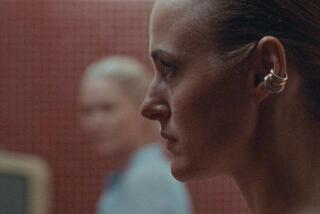‘Quo Vadis’: A Straightforward, Old-School Epic From Poland
Polish filmmakers recently have been making new versions of their country’s beloved 19th century novels, none more cherished than those by Henryk Sienkiewicz.
The veteran Jerzy Kawalerowicz, who turns 80 this year, has completed an elaborate version of Sienkiewicz’s most famous work, “Quo Vadis,” said to be Poland’s biggest movie ever.
A splendid-looking film with elaborate sets and a cast of thousands, it is a straightforward, traditional screen narrative of considerable clarity, which is a big plus because too many of the literate English subtitles are washed out, thanks to white lettering on light backgrounds.
If memory serves, Mervyn LeRoy’s 1951 version hasn’t the nuances and shadings in its characterizations as Kawalerowicz’s rendering of the novel, but it is surely more entertaining. Michal Bajor’s Nero, for example, is more complex than Peter Ustinov’s, but it isn’t as much fun.
The problem that besets any adaptor of “Quo Vadis” is that its story is slow getting underway, despite its essential simplicity. Marcus Vinicius (Pawel Delag), high-ranking Roman military officer, falls for Lygia (Magdalena Mielcarz), the daughter of the king.
She has been taken hostage by Nero’s forces but enjoys the protection of Marcus’ uncle, Petronius (Boguslaw Linda), who represents the epitome of Roman civility and erudition--he is the author of “The Satyricon”--and is skillful enough to be the one man trusted by the increasingly deranged and capricious Nero.
Marcus makes the mistake of demanding Lygia as a concubine, for despite their mutual attraction, she cannot accept him on those terms. She manages to escape his clutches momentarily, and by the time Marcus catches up with her, he has seen the light and converts to her Christian religion.
Unfortunately, about then the crazed Nero has ordered Rome burned, only to discover its citizens are in understandably sufficient uproar to need a scapegoat. What to do but blame the Christians for setting the city on fire and feed them to the lions in the Colosseum?
Kawalerowicz directs with briskness and vigor but cannot keep the first half of his film from slipping into tedium. His “Quo Vadis” has the look, feel and morality of a Cecil B. DeMille epic--how did DeMille happen not to make a version?--but without the sustaining energy.
The film gradually becomes more involving, powerful and ultimately spiritual. Yet it is essentially old-fashioned in conception and seems remote in comparison with “Gladiator,” which made the events in antiquity seem to be happening in the present.
As in LeRoy’s film, Petronius is the most fully realized character, and Linda, a stalwart of the Polish cinema, gives a subtle performance of a reflective, urbane and ultimately courageous man that recalls that of Leo Genn in the earlier version, who may well have been for youthful viewers in 1951 the first intellectual on the screen.
Marcus and Lygia are pretty much stock hero and heroine parts, but both Delag and Mielcarz impress. Bajor shows us a Nero in constant torment and conflict, his fleeting decent impulses short-circuited by megalomania and paranoia. Franciszek Pieczka is commanding and persuasive as the Apostle Peter.
To watch this new “Quo Vadis” is to suspect that there’s a good chance that either of the two major Italian silent versions--one made in 1912, the other in 1924 with Emil Jannings as Nero--is ultimately more successful than either LeRoy’s or Kawalerowicz’s films or several other versions, for that matter. That’s because the silent film, with its inherent stylization, may well be the most effective medium for such florid, emphatically 19th century material.
Unrated. Times guidelines: some strong violence, some nudity.
‘Quo Vadis’
Pawel Delag...Marcus Vinicius
Magdalena Mielcarz...Lygia
Boguslaw Linda...Petronius
Michal Bajor...Nero
A Chronos Film release of a co-production of Telewizja Polska, Kredyt Bank, HBO, Studio Filmowe KADR. Writer-director Jerzy Kawalerowicz; based on the novel by Henryk Sienkiewicz. Producer Miroslaw Skowinski. Executive producer Jerzy Kajetan Frykowski. Cinematographer Andrzej J. Jaroszewicz. Editor Cezary Grzesiuk. Music Jan A. P. Kaczmarek. Costumes Magda Teslawska, Pawel Grabarczek. Production designer Janusz Sosnowski. Running time: 2 hours, 45 minutes. In Polish, with English subtitles.
Exclusively at the Monica 4-Plex, 1332 2nd. St., Santa Monica, (310) 394-9741.










